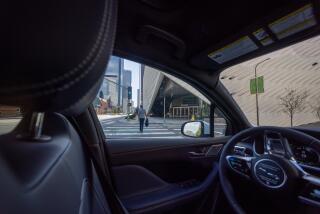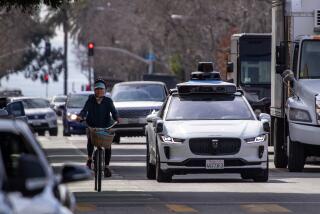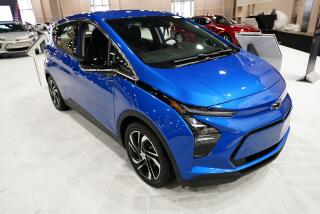Study Questions Safety of SUVs
- Share via
Which is safer, a Honda Accord or the nearly one-ton- heavier Ford Expedition? Chances are that the brawny SUV would hold up better in a wreck.
Yet drivers of Accords and Expeditions have about the same risk of suffering a fatal accident, new research shows. And when the risk to other drivers is factored in, the Accord is safer by far.
Or consider the massive Chevrolet Suburban, identified by the research as safest among popular SUVs. But according to the data, drivers of Suburbans and shrimpy Volkswagen Jettas have about the same fatality rates.
The novel study’s bottom line: Sport utility vehicles and pickups aren’t as protective as many of their owners believe, while they are also uniquely dangerous to everyone else.
The auto industry maintains that SUVs have contributed to a decline in the rate of highway deaths because heavier vehicles are safer for their drivers. “SUVs have an excellent safety record, and they’re as safe as cars,” said Eron Shosteck of the Alliance of Automobile Manufacturers, a leading industry group.
But Marc Ross of the University of Michigan, co-author of the study with Lawrence Berkeley National Laboratory scientist Thomas Wenzel, contends that a hard look at the data indicates otherwise.
Indeed, the study takes a contrarian jab at an iron maxim of highway safety: that heavy is good and heavier is better.
“We need to ... move away from the idea that bigger and heavier vehicles are automatically safer,” said Ross, a physicist. “Quality is a bigger predictor of safety than weight.”
Ross and Wenzel’s research is believed to be the first to assess fatalities among both drivers of various vehicles and the people they collide with. It comes amid a growing backlash against SUVs and other light trucks, among the most popular yet polarizing of consumer products.
Flying off dealers’ lots, light trucks now account for more than half of vehicle sales and are responsible for a steady decline in fuel economy and growing dependence on foreign oil. Many consumers consider the gas-slurping vehicles to be safer than cars. That, in turn, has relieved pressure on automakers to produce more fuel-efficient vehicles.
Riding high behind the wheel of her silver Expedition, Angie Garcia of Sylmar said the SUV looks great and provides a sense of security she would not have in a car. “I definitely feel it’s safer
Feeling outgunned in a vehicular version of the arms race, other drivers have simply resigned themselves to SUVs.
“I was getting mowed down by the larger SUVs and trucks,” said Jennifer Mulcahy of Simi Valley, who dumped her small car in favor of a Nissan Xterra. “It just felt intimidating.... It was survival of the fittest.”
Despite such sentiments, Wenzel and Ross say, SUVs and pickups on average provide less protection for their drivers than most large or even mid-size cars.
A primary reason: Unlike cars, which tend to slide sideways when they go out of control, SUVs and pickups, with their high center of gravity, are more likely to flip over. That’s important because rollovers are the most lethal accident type, accounting for only about 3% of wrecks but 30% of deaths to vehicle occupants.
Originally published last March, Wenzel and Ross’ little-noticed study assigned a “combined risk” number to each vehicle -- defined as the fatality rate for drivers of the model plus the death rate for drivers they crash into. The study used the Fatality Analysis Reporting System, a federal database, to compute death rates for drivers of 1995 through 1999 model-year vehicles. Their research was funded by the Energy Foundation, which includes the Pew Charitable Trusts, the MacArthur Foundation and the Rockefeller Foundation.
At the request of The Times, Wenzel and Ross updated the analysis for model years 1997 to 2001.
Although they did not dispute the numbers, other experts said they may not tell the whole story.
In “all the studies we have done ... weight has a very substantial protective effect,” said Priya Prasad, a senior technical fellow for safety at Ford Motor Co. “Heavier is better, especially when you get into two-way accidents.”
Wenzel and Ross acknowledged that driver-related factors could account for some differences in risks of various models. For example, if a certain vehicle attracts drivers who tend to wear seat belts, obey speed limits and get into fewer accidents, that car or truck could appear to be safer than it really is.
But they said driver characteristics couldn’t account for their most important finding -- that light trucks’ reputation for safety is overblown and that their combined risks are greater than those of most cars.
Specifically, their data show that:
* Despite giving up considerable size and weight, most mid-size and large cars are as good as or better than the average SUV at protecting their own drivers, and much more protective of their drivers than the average pickup.
* Particularly dangerous to other motorists in two-vehicle wrecks, SUVs have higher combined risks than mid-size and large cars. Their combined risks are similar to those for compacts and subcompacts.
* The safest compacts and subcompacts -- the Volkswagen Jetta, the Mazda 626, the Subaru Legacy and the Nissan Altima -- have driver death rates as low as or lower than that of the average SUV. Still, compacts and subcompacts have higher driver death rates than SUVs overall. The reason: The most unsafe small cars have extremely high driver fatality rates, two to three times worse than the best cars in the group.
* Minivans, and luxury import cars with their advanced safety features, have lower driver death rates than all other vehicle types. Minivans, like SUVs and pickups, are considered light trucks but are not as top-heavy and therefore are less susceptible to deadly rollovers. Along with design differences, minivans often are used to transport children, perhaps leading people to drive more conservatively.
* Driver death rates for pickups are higher than for all other vehicle types, except for sports cars. The risks are markedly higher than for large and mid-size cars, minivans and SUVs; somewhat higher than for compacts; and similar to those for subcompact cars. Below-average use of seat belts by pickup drivers may be a contributing factor.
* Pickups also are more lethal to other drivers than are SUVs, minivans or any class of cars. Their combined risk is about twice that of large and mid-size cars and about 50% higher than that of SUVs, compacts and subcompacts.
* In all classes of cars, Japanese and European models did better on average than their American counterparts, especially in protecting their own drivers. This was particularly striking among compacts and subcompacts. The six safest models (the Jetta, the Altima, the Legacy, the 626, the Honda Civic and the Toyota Corolla) bear Japanese or European nameplates. By contrast, American cars (the Pontiac Sunfire, the Dodge Neon, the Chevrolet Cavalier, the Pontiac Grand Am) had the highest driver death rates in those categories.
The Ross-Wenzel study has emerged at a time of growing concern about the social costs of SUVs, which have long been attacked as harmful to the environment and U.S. energy goals.
Coining the slogan “What would Jesus drive?” a religious group calling itself the Evangelical Environmental Network launched an ad campaign seeking to shame drivers out of their SUVs. The Detroit Project, spearheaded by columnist Arianna Huffington, has run its own ads linking the gas-guzzling vehicles to the funding of terrorists.
More recently, questions have been raised about the safety of SUVs. For instance, an article in the December issue of the Boston University Law Review brands SUVs as “probably the most dangerous products (other than tobacco and alcohol) in widespread use in the United States.”
No expert contends that, all other things being equal, heavier vehicles aren’t safer for their passengers than are light ones.
“If you put the same technology and the same design concepts into the small vehicle and the large vehicle, the large vehicle is going to protect its occupants better,” said Adrian Lund, chief operating officer for the Insurance Institute for Highway Safety.
Still, Lund acknowledged, at some point that weight becomes a negative in the total equation -- killing a larger number of other motorists than are saved in the heavier vehicles. According to Lund, this threshold is crossed at roughly 4,000 pounds, a little less than the weight of a Ford Explorer or other small to mid-size SUVs.
With this idea in mind, Wenzel and Ross say, the goal should be to make the biggest models more compatible in size and weight with the rest of the fleet.
Meanwhile, prompting great concern in the auto industry, the chief of the National Highway Traffic Safety Administration also has taken aim at SUVs, saying they pose unacceptable risks to their own passengers as well as to other drivers.
Addressing a gathering of industry executives in Detroit last month, Jeffrey W. Runge said he had appointed a panel of NHTSA officials to consider new safety regulations for SUVs -- though it’s clear that it would take years for such rules to be adopted.
Responding to Runge’s blast, General Motors Corp. said that SUVs “have contributed to the dramatic decline in the nation’s fatality rate over the last decade.”
In fact, there have been modest declines in fatality rates -- as measured by deaths per total vehicles and vehicle miles traveled. But the death toll has been stuck at about 42,000 a year -- despite wider use of seat belts, stricter vehicle safety standards and better automotive designs.
One reason for this, experts say, is that safety advances have been partly negated by a growing mismatch in size between light trucks and cars. When light trucks collide with cars, the high-riding vehicles can override bumpers and door sills and strike occupants in the chest or head.
Faced with Runge’s threat of new regulations, the Alliance of Automobile Manufacturers said last week in a joint letter with the Insurance Institute for Highway Safety that the organizations would work together to make SUVs safer.
Some manufacturers already have begun taking steps to reduce the danger to cars posed by certain light-truck models.
For example, Ford and GM have lowered bumper heights on some models to reduce the risk of override. And in response to safety and fuel efficiency concerns, manufacturers are increasingly pushing “crossover” models -- smaller, more car-like SUVs that inflict less damage in collisions.
*
(BEGIN TEXT OF INFOBOX)
Fatality risk by vehicle type
An analysis shows that the combined fatality risk for SUVs and pickups is higher than for most types of cars. The combined risk for a model is the sum of the death rate for its drivers and the drivers of other vehicles with which it collides.
Combined risk of vehicles by category
(Driver deaths per million vehicles sold, 1997-2001 model years, based on vehicle sales numbers from Ward’s Motor Vehicle Facts and Figures, 2002.)
*--* Driver deaths Other driver deaths Combined risk Luxury import 40 20 60 Minivan 40 40 80 Mid-size car 66 32 97 Large car 74 38 112 Compact 90 38 128 SUV 79 53 132 Subcompact 109 33 141 Pickup 108 103 211 Sports car 175 50 225
*--*
Note: Analysis by Thomas Wenzel of the Lawrence Berkeley National Laboratory and Marc Ross of the University of Michigan. Driver death figures from the National Highway Traffic Safety Administration’s Fatality Analysis Reporting System. Because of rounding, combined risk may differ slightly from the sum of driver risk plus other driver risk.
*
(BEGIN TEXT OF INFOBOX)
Fatality risk by model
Here is a look at the combined fatality risk for various vehicles by model. The combined risk for a model is the sum of the death rate for its drivers and the drivers of other vehicles with which it collides.
Combined risk of vehicles by model
(Driver deaths per million vehicles sold, 1997-2001 model years, based on vehicle sales numbers from Ward’s Motor Vehicle Facts and Figures, 2002.)
*--* Other Driver driver Comb Make and model Vehicle type deaths deaths risk Toyota Avalon large car 40 20 60 Chrysler Town&Country; minivan 31 36 67 Toyota Camry mid-size car 41 29 70 Volkswagen Jetta subcompact 47 23 70 Ford Windstar minivan 37 35 72 Dodge Caravan minivan 37 38 75 Nissan Maxima mid-size car 53 26 79 Honda Accord mid-size car 54 27 82 Chevrolet Venture minivan 51 34 85 Buick Century mid-size car 70 23 93 Subaru Legacy/Outback compact 74 24 98 Mazda 626 compact 70 29 99 Mercury Sable mid-size car 75 27 102 Cadillac DeVille large car 66 39 105 Chevrolet Malibu mid-size car 71 34 105 Chevrolet Suburban SUV 46 59 105 Jeep Grand Cherokee SUV 61 44 106 Honda Civic subcompact 84 25 109 Pontiac Grand Prix mid-size 76 33 109 Toyota Corolla subcompact 81 29 110 Ford Expedition SUV 55 57 112 GMC Jimmy SUV 76 39 114 Dodge Intrepid large car 71 45 116 Ford Taurus mid-size car 78 39 117 Chevrolet Astrovan minivan 58 61 118 Nissan Altima compact 72 49 121 Mercury Marquis large car 80 43 123 Saturn SC/SL/SW subcompact 98 26 124 Nissan Sentra subcompact 95 34 129 Buick LeSabre large car 96 37 133 Toyota 4Runner SUV 94 43 137 Chevrolet Tahoe SUV 68 74 141 Dodge Stratus mid-size car 103 40 143 Lincoln Town Car large car 100 47 147 Ford Explorer SUV 88 60 148 Pontiac Grand Am compact 118 39 157 Toyota Tacoma pickup 111 59 171 Chevrolet S-10 Blazer SUV 122 50 172 Dodge Dakota pickup 74 110 184 Chevrolet Cavalier subcompact 146 41 186 GMC C/K pickup 101 92 193 Jeep Wrangler SUV 136 58 194 Ford Ranger pickup 118 78 196 Dodge Neon subcompact 161 39 199 Pontiac Sunfire subcompact 158 44 202 Chevrolet C/K pickup 104 99 203 Chevrolet S-10 pickup 161 55 216 Dodge Rampickup 88 137 225 Ford F-Series pickup 110 128 238
*--*
Note: Analysis by Thomas Wenzel of the Lawrence Berkeley National Laboratory and Marc Ross of the University of Michigan. Driver death figures from the National Highway Traffic Safety Administration’s Fatality Analysis Reporting System. Because of rounding, combined risk may differ slightly from the sum of driver risk plus other driver risk.






